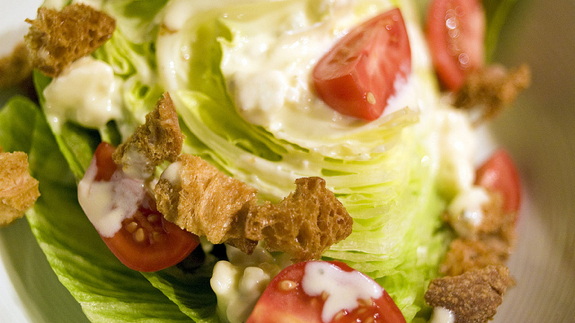Tip of the Iceberg: Our Love-Hate Relationship With the Nation’s Blandest Vegetable
It’s never been the most nutritious green at the grocers, but the versatile lettuce has a knack for sticking around on the dinner table
![]()
These days, the classic wedge salad—wherein the chef smothers a chunk of crisp Iceberg lettuce with creamy blue cheese dressing, and crumbles bacon all over the top—is seen as a cornerstone of American “comfort food.”
The dish is also often credited with single-handedly causing an “Iceberg comeback.” All of this raises the question: Did this crisp salad green, the “polyester of lettuce,” really go so far away that it needed to come back? And if so, can one menu item really make a difference?
But first a note—for those who aren’t old enough to remember—about just how ubiquitous Iceberg lettuce once was. Introduced for commercial production in the late 1940s, Iceberg (or crisphead) lettuce was the only variety bred to survive cross-country travel (the name Iceberg comes from the piles of ice they would pack the light green lettuce heads in before the advent of the refrigerated train car). Therefore, throughout the middle of the century, unless you grew your own or dined in a high-end establishment, iceberg essentially was lettuce.
Most of the nation’s lettuce is grown in California, and in 1974, leafy green “non-crisphead” varieties of lettuce still made up only around five percent of the total acres grown in California. Then things changed. For one, consumers became more aware of the nutritional value of greens that are, well, greener. (Made of a high percentage of water, iceberg has only around 1/20th the amount of vitamins as the darker leafy greens, says David Still, a plant science professor at California State Polytechnic University at Pomona.)
America’s everyday lettuce for half a century was losing market share. By 1995, other lettuce varieties made up to around 30 percent of the lettuce American’s ate, and it has been rising steadily since, according to the California Leafy Greens Research Programs (a salad industry group). That’s precisely why, by 2007, the Salinas, California-based Tanimura and Antle—the nation’s largest lettuce supplier—decided it needed to start promoting Iceberg. And rather than compete with varieties that have more flavor or nutrition, Tanimura and Antle went straight for nostalgia, and opted to draw a connection to steaks, fathers, and sports. A press release from the time reads:
Mother’s Day has strawberries, Thanksgiving has celery, but historically no holiday has been associated with Iceberg lettuce,” says Antle. “What better product to claim ownership of Father’s Day than the cornerstone salad of steakhouse menus?
Wal-Mart, Albertsons, and several other big retailers hung signs and banners promoting the campaign, and sales got a boost. The company also planted wedge salad recipes around the food media world, in hopes that they would inspire chefs to return to this American Classic.
It’s hard to say whether the Father’s Day angle made a difference, but the larger effort to reconnect to Iceberg to simpler times with fewer complicated health choices appears to have worked. Sort of.
On the one hand, chefs like the fact that Iceberg is a completely neutral way to add crunch and filler to an otherwise flavorful medley of ingredients. So it appears that this classic salad will be sticking around on menus for a while. (Last fall the San Francisco Chronicle ran a list of nearly a dozen upscale restaurants serving some variation on the wedge salad, including everything from croutons, to apple, walnuts, and avocado. One Napa restaurant even serves it with the Iceberg frozen for extra crispness.)
On the production level, however, Iceberg may never return to it’s reigning position. It’s a little cheaper to grow and has long been easy to ship and store (the name Iceberg is said to come from the way the round lettuces were shipped by train in big piles of ice), but it has a hard time standing up to romaine, butter, and all the other specialty greens that have become popular in recent years.
This also appears to be true outside the U.S. In 2011, for example, UK-based Telegraph declared: “The era of Iceberg lettuce is over,” as “bagged leaf varieties such as and watercress are up by 37 per cent compared to last year.” Of course, it may never be hard to find Iceberg lettuce in fast food tacos and Sizzler salad bars. But the decline of Iceberg might also signal some good news for Americans’ diets.
“Iceburg sales have gone down, but romaine has gone up,” says Mary Zischke from the California Leafy Greens Research Programs. “Tastes have changed. And the darker, leafy greens have a better story to tell from a nutrition standpoint.”
Compared to 20 years ago, Zischke added, “there are a lot more choices. Especially in some parts of the country, like the Midwest.” Overall, she’s glad to report that: “The product mix has changed, but our industry has also gotten bigger.”
